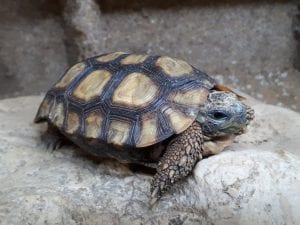This species of tortoise is a highly evolved species with excellent protection from predators by means of a fully closable shell design. Once closed the rear legs are not available to be bitten. They have also evolved to live in a very specific habitat – hot and dry most of the year, with a specific wet season. They are quite a flat species, ideal for living in rocky terrain. For this reason they have some very different requirements to more commonly kept tortoise species. They occur in savannah dry bush areas in East Africa. This effects their heat, light and diet requirements – not to mention the challenge of replicating their natural terrain.
 Speke’s Hingebacks are not a large species rarely growing more than around 20cm. For this reason a large enclosure is not required. We would suggest an absolute minimum of a four feet long enclosure for one tortoise, more being preferable. There is great debate about the style of enclosure, the great tortoise vivarium versus table debate. We have kept, long term many species of tortoises in vivaria with no issues at all, and many of our customers also choose a vivarium with no reported long term problems. A vivarium, for the less experienced keeper could be argued is an easier to set up and maintain enclosure regrading heating – an enclosed enclosure will always be easier to temperature control. From our experience we suggest it is a very personal decision.
Speke’s Hingebacks are not a large species rarely growing more than around 20cm. For this reason a large enclosure is not required. We would suggest an absolute minimum of a four feet long enclosure for one tortoise, more being preferable. There is great debate about the style of enclosure, the great tortoise vivarium versus table debate. We have kept, long term many species of tortoises in vivaria with no issues at all, and many of our customers also choose a vivarium with no reported long term problems. A vivarium, for the less experienced keeper could be argued is an easier to set up and maintain enclosure regrading heating – an enclosed enclosure will always be easier to temperature control. From our experience we suggest it is a very personal decision.
Heating needs to be overhead, this can be in the form of ceramic, filament or halogen. There is no perfect heater, all have their compromises and none provide a fully natural heating provision. Again, there is much debate. We would certainly suggest, especially in a vivarium, that heating and lighting is provided separately to provide total control of each. This rules out mercury vapour and metal halide bulbs (as these cannot be connected to a thermostat) – however these can be utilised in large enclosures. Our first choice would be ceramic, followed by filament for a vivarium – but its again another personal choice. Daytime temperatures need to be around 30-32C in a basking area, with plenty of opportunity to move to cooler areas. Night time can drop to around 30C. Seasonal variation is another topic, some suggest its vital, others argue its more natural and others get good results from not altering temperatures according to season. Certainly its very important to remember this species doesn’t hibernate – it would die at low temperatures.
Lighting is another topic where no artificial product gives the perfect natural light – mainly in levels of luminance (in stripped down easy terms, “brightness”). Halogens are often used for their intense light, but its still well below natural sunlight, filament bulbs are less than useless (similar luminance to shade) and even some of the better performers such as metal halide and T5 are well below natural sunlight. However, as we often find, even when providing less than perfect conditions, reptiles adapt and thrive. We would in most cases suggest a 12{cb5d0a8cf0c44aef2db327d9ab0dba08dd09aed1126b509e5fa01d3aaa87fe47} T5 UVB fluorescent tube, and perhaps metal halide or mercury vapour in an open top larger enclosure. The provision of UVB is critical – there is a 14{cb5d0a8cf0c44aef2db327d9ab0dba08dd09aed1126b509e5fa01d3aaa87fe47} T5 commercially available, and this could be useful if the tube needs to be mounted further away than optimum for a 12{cb5d0a8cf0c44aef2db327d9ab0dba08dd09aed1126b509e5fa01d3aaa87fe47} tube. The UVB provides vitamin D3, which in turn allows the utilisation of calcium within the body.
There are many choices of floor covering – keepers that prefer a more minimal method may use beech chip. Those that prefer a more natural provision will likely aim for one of the soil mixes on the market, such as Prorep Desert Life. The use of a soil based substrate will allow a more natural digging behaviour and also by careful monitoring and topping up of water, will provide differing levels of moisture in the soil. A variety of rocky terrain and hides will provide shade, enrichment and a variety of temperatures and levels of UVB.
Diet is again, different to the more commonly kept Hermanns, Horsfields and Spur-thighed tortoises. Along with the more usual tortoise fair (see our other guidance on this topic) its important to use drier grasses and also insects – in particular snails and worms. All food should be supplemented with a good quality multi-vitamin and calcium powder. Again, like most aspect in modern reptile keeping there is much debate , some keepers use no vitamin D supplements if UVB lighting is provided. Again, it’s a personal choice, and of yet there is little evidence to support the various opinions.
